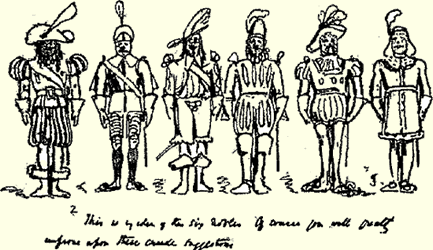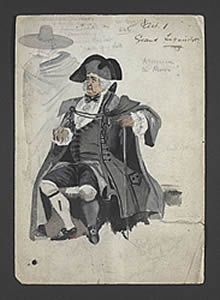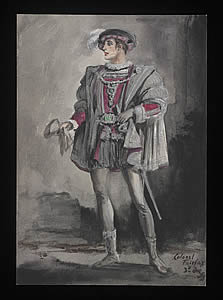 |
 |
||||||
by Miss G. B. Crozier
[From the January 1920 edition of The Strand]

HE gay and exquisite music and merry quips and jokes of the Gilbert and Sullivan operas — fresh during this New Year Season as they were thirty and forty years ago—have once again taken the own by storm. The general beauty of decoration in the present production excels all previous records, and forms an ideal background for the dresses designed by Mr. Percy Anderson which show a loveliness undreamed of thirty years ago, when the original designs for the first performances of "The Gondoliers" and "The Yeomen of the Guard" were made — embodying Sir W. S. Gilbert's conception of each character as seen in his mind's eye.
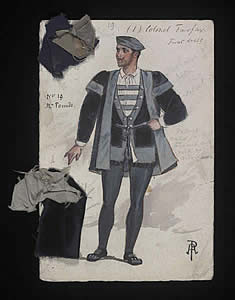 |
| DESIGN BY PERCY ANDERSON FOR THE COSTUME WORN BY COURTICE POUNDS IN THE ORIGINAL PRODUCTION OF "THE YEOMEN OF THE GUARD" |
Readers will be specially interested to see some of these early costume drawings of Mr. Percy Anderson's, which, executed in faint watercolour, with scraps of gaily-hued silk, cloth, and wool, still pinned to the edges as guides to the costumier for material and colour, are reproduced amongst the illustrations, together with some new 1919 sketches which show the immeasurably greater freedom and imagination with which the famous designer of "Chu Chin Chow" renown, while keeping to the old Savoy traditions, now carries out such work.
Sir W. S. Gilbert's exact method of suggesting the effect he wanted is clearly seen in the two interesting sketches for characters in "The Grand Duke," which were drawn over twenty years ago on stray bits of paper in pen and ink and sent to Mr. Anderson, who lately came across them again when turning out some papers.
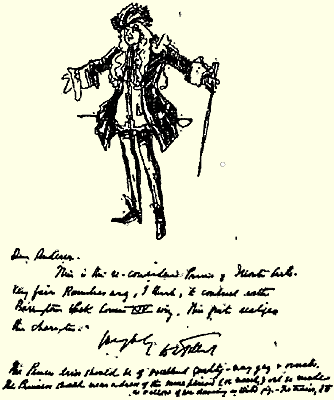 |
| This is the reconsidered Prince of Monte Carlo. Very fair Ramilles wig, I think, to contrast with Barrington's black Louis XIV wig. This quite realises the character. The Prince's dress should be of excellent quality — very gay and ornate. The Princess should wear a dress of the same period (or nearly), but made as to allow of her dancing a wild jig. — No train. |
H. A. LYTTON'S RECOLLECTIONS
That fine old Savoyard, Mr. H. A. Lytton, has some recollections of the old days when on tour, which are highly entertaining.
Once when playing John Wellington Wells in "The Sorcerer" (where it will be recollected that in the last act the Sorcerer disappears amidst red fire) something went wrong with the trap and it stuck when he had only disappeared half way! There was nothing for it but to climb out, and walk ignominiously off stage. As he did so a voice from the front was heard to exclaim, "Hell's full!" — "a remark," says Mr. Lytton, "which gained the greatest applause of the evening." An ardent believer in "luck," Mr. Lytton declares that his lucky number is thirteen. He signed his first contract with the late Mr. D'Oyly Carte on the 13th of the month, and that he rightly regards as a very special piece of luck! Then when specially hard up he scraped together all he could and went off with some friends to Monte Carlo. Going straight to the tables, he planked down all he had on No. 13, and won enough to spend a delightful holiday on the proceeds. He was in London thirteen years, then played out of London for thirteen years. The telephone number of his house starts with thirteen, and to complete the story, when recently on tour he bought up all the boots he could lay hands on at the provincial towns through which they passed, against a rainy day, and on counting up the number of which he had kept no count, found that they amounted to thirteen!
His talent for "making up" amounts to genius, as for example, in "The Pirates of Penzance," in successfully depicting two such widely-contrasting individuals as the dapper little Major-General — a little cock-sparrow of a man — and the towering Pirate King, a part in which, with the help of various mechanical aids — faked shoulders, and the like, — he performs the perfectly amazing feat of "making up" his height to six feet two.
Mr. Lytton and his company had some rather rough times when on tour during the war, and at one time were constantly in the thick of Zeppelin raids. They were at Sheffield when the town was bombed, and on going on to Hull met with a similarly warm reception, and on arrival in London within a few days were called on to face another severe raid, causing poor Fred Billington — that much missed Savoyard who shared his dressing-room — to remark: "Harry! I believe the Kaiser's got our tour!"
SOME STORIES OF GILBERT.
Listening to the recollections of incidents which happened over forty years ago, there is a fascination in learning from a close family friend how W. S. Gilbert, when at work on "The Mikado," went round to see her with the verses for "Three Little Maids from School are We" in his pocket.
Taking them out he read them aloud and awaited her verdict — which predicted a great success. "Ah!" he replied, doubt in his eyes, "I wonder — I wonder!" The greatest writers are often the worst judges of what will prove popular in their own work.
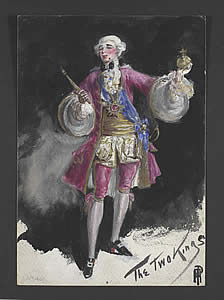 |
| DESIGN FOR THE KINGS' DRESSES IN THE PRESENT REVIVAL OF "THE GONDOLIERS." |
It was for the same friend that he drew a admirable caricature of himself in the manner of the "Bab Ballads" illustrations, with a large head — an excellent likeness — and dwindling body, on a treasured fan which already bore sketches by Sir John Tenniel, du Maurier, Linley Sambourne, and others, prompting the characteristic note which accompanied the return of the fan, and ran as follows: "I have done my best, but I am afraid my right hand has lost the cunning it once possessed. Certainly I have failed to impart to the individual represented any expression of that modesty and diffidence which he should feel at finding himself in such distinguished society. [Note: This drawing is reproduced in the original article, but unfortunately our copy is too poor to be included here.]
"The Lady of the Fan," to whom the writer is indebted for many charming recollections, having the double misfortune to lose both husband and almost all her income at one blow, was carried off by W. S. Gilbert and his warm-hearted wife and kept with them for weeks, while her own house and furniture were sold, and a tiny residence suited to her slender resources found and fitted up for her. Here W. S. Gilbert worked, as she describes it, "Like a carpenter!" He hung pictures, and did innumerable odd jobs, to make the little house look like a home, and noticing a bare space in the sitting room, for all the large furniture had been sold, he sent a couple of exquisite little Chippendale book-case-cabinets to fill the gap, which still stand where he placed them, to hold her favourite books.
"I HAVE A SONG TO SING O!"
A propos of the writing of "The Yeomen of the Guard," it seems that Sir William Gilbert used to attribute his first inspiration for that most famous of duets between the Merry Man and his Maid, "I have a Song to Sing O!" to an old Cornish chanty sung by the sailors on board his yacht. It was a great favourite of his, and is so quaint and altogether delightful that a friend who has often sung in it with the Gilberts and some party of young friends — Sir William leading as "Questioner" — has most kindly copied it out from memory — for it has never before, she thinks, been written down.
It runs as follows:
| Come and I will sing you. What will you sing me? I will sing you twelve O! What is your twelve O? Twelve are the twelve Apostles. Eleven of them have gone to Heaven, Ten are the Ten Commandments, Nine is the Moonlight bright and clear, Eight are the eight Archangels, Seven are the seven stars in the sky, Six are the cheerful Waiters, Five are the ferrymen in the boat, Four are the Gospel Preachers, Three of them are strangers, Two of them are lily-white maids, Dressed all in green O! One of them is all alone And ever will remain so. |
THE GRAND INQUISITOR'S DRESS AS DESIGNED FOR THE
ORIGINAL PRODUCTION OF "THE GONDOLIERS" IN 1889. |
The way it is sung is:—
| 1ST SINGER: | |
| "Come and I will sing you." | |
| QUESTIONER (the same singer throughout): | |
| "What will you sing me?" | |
| 1ST SINGER: | |
| "I will sing you one O!" | |
| QUESTIONER: | |
| "What is your one O?" | |
| 1ST SINGER: | |
| "One of them is all alone And ever will remain so." |
|
| CHORUS: | |
| "One of them is all alone And ever will remain so." |
|
| 2ND SINGER: | |
| "Come and I will sing you." | |
Now, it seems that there was an informal pact between W. S. Gilbert and Arthur Sullivan that when the former handed a libretto to the latter he should never give him any suggestion as to a rhythm or air which might be running through his head whilst writing it, lest it should throw out the other's musical inspiration set in motion by the verses.
When the "Merryman" song was handed to Sir Arthur, however, he declared that for a time it baffled him completely, and he finally went to Gilbert to ask if he could hive him any clue as to his own source of inspiration on the chance that he could "dip a bucket in the same well!"
"I will give you one O!" chanted W. S. Gilbert, softly.
"I have it! Of course!" swiftly replied Arthur Sullivan, and the melodiously ingenious number which has held audiences spellbound in five continents was the result.
AT GRIM'S DYKE.
Some nine and twenty years ago the Gilberts moved to their beautiful house, Grim's Dyke, near Harrow, where they continued to entertain most hospitably, and here Lady Gilbert still lives.
It is a storehouse of treasures, many of which have a history connected with the operas, while the very arrangement of the rooms will often recall some whimsical Gilbertian jest or fancy! There is a charming alcove in the stairs leading from the billiard-room to a long drawing room, scene in the old days of many a delightful dance, and this Sir William had fitted up with charming rose brocade-covered cushions and softly shaded lamps, and quaintly dubbed "The Flirtorium!"
As quite a young man, W. S. Gilbert served for a short time in the Royal Naval Reserve, and later he owned a yacht in which he and his wife cruised about for seven successive summers, and the keen love of the sea which so constantly peeps out in his work was only equaled by his acquaintance with all seafaring lore. His knowledge of ships and shipping astonished even sailors.
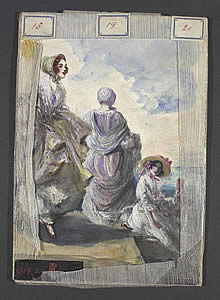 |
| SKETCH FOR THE DRESSES OF THE MAJOR-GENRAL'S DAUGHTERS IN THE PRESENT PRODUCTION OF "THE PIRATES OF PENZANCE" |
In complicated rigging he took special delight, and one of the greatest treasures at Grim's Dyke is a fifteen-foot-model of the old Queen, who played her part in Nelson's day, from which the after-part of H.M.S. Pinafore was exactly copied for the first revival of the opera. It is still kept in perfect order by the Rigging Expert of the Admiralty Museum at Whitehall, Mr. John Smith, who last year spent his three weeks' summer holiday at Grim's Dyke, working several hours a day upon this beautiful piece of handicraft, which — standing in the hall — is an object of much interest to visitors, who seldom fail to ask its history. In the billiard-room — the walls of which are lined with large black frames containing portraits of the original members of the casts of the first productions of the operas, one also sees the Headsman's Block and Axe used in the first production of "The Yeomen of the Guard," and the huge gong used in the same play, which, when struck, rings for four minutes, while the original drawings made to illustrate the "Bab Ballads" hang in long narrow frames on either side of the wide window.
At a time when Limericks were in the air, a group of young people seated on the lawn were quoting them to one another while awaiting tea, when, just as the tea-kettle and tray of cakes appeared, Sir William neatly interposed with the following:—
| There was a young lady of Gilham, Who sat down to tea by Sir Willum, |
|
| She said "We're not Mummies, We've all of us Tummies, |
|
| AND NOW IS THE MOMENT TO FILL 'EM!" | |
Page modified 16 December 2017
